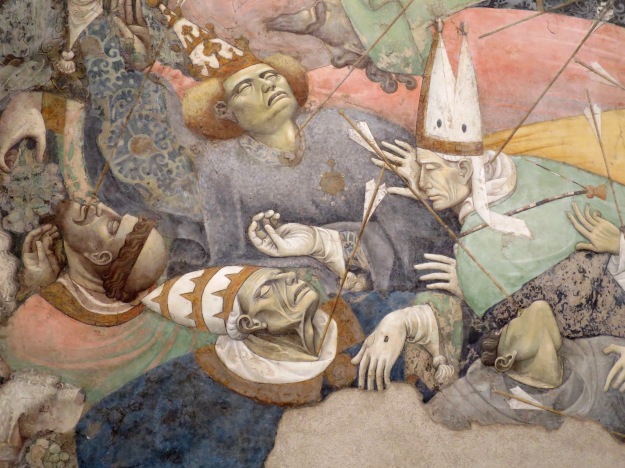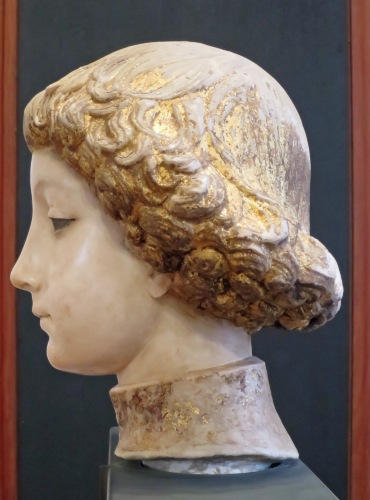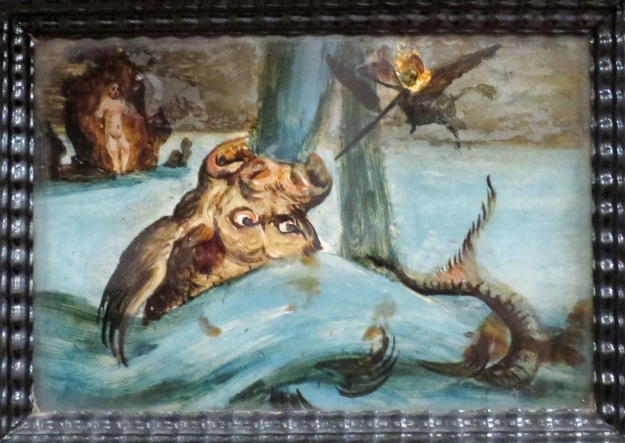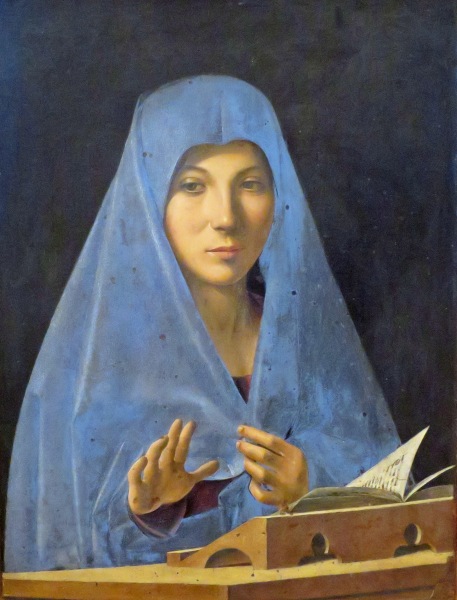The Palazzo Abatellis, along with so much of Palermo’s Kalsa District (the old Arab quarter), was damaged extensively by Allied bombing in WWII. As Jeremy Dummett writes:
The destruction of Palermo from these air raids was worse than anything in the city’s previous history. The historic center was partially destroyed, with the port and the Kalsa district reduced to piles of rubble. . . . Those unable to leave huddled in the buildings that were still habitable, increasingly short of food and basic supplies. [Jeremy Dummett, Palermo, City of Kings: The Heart of Sicily, p. 129]
The renascence of La Kalsa is all the more remarkable, given the extent of the loss, and Palazzo Abatellis constitutes a stunning example of what has been achieved.
As part of the restoration, Venetian architect Carlo Scarpa created within the Palazzo’s walls the exhibition space that now holds the Galleria Regionale della Sicilia (Gallery of Art for the Sicilian Region).
The present arrangement of the collections in the rooms of Abatellis Palace – restored after bombing of 1943 – is the result of the collaboration between Giorgio Vigni and the Venetian architect Carlo Scarpa during the two years 1953-54. The main aim was that of making “live . . . in harmony the architecture of the palace and its content” . . . [citation]
The Triumph of Death, a towering 15th C fresco by an unknown artist, has pride of place in an ancient chapel, where light streams down from a dome above. Its subject matter, “the personification of Death, and the theme of the triumph of death, was widespread in the Middle Ages, both during and after the Black Death which devastated the population of Europe in the 14th century.” As is apparent from the detail shown above, death is democratic, falling upon powerful and powerless alike. [citation]
Upstairs, galleries include graceful busts by Francesco Laurana (1458-1502).
. . . Laurana was entirely unknown until about 1880. Even now his life is mysterious, partly because he worked outside the mainstream of Italian art. He was born in Dalmatia, in modern Croatia, which had been colonized by Venetians and was open to the influences of Italian culture. . . . His reputation is largely based on a series of elegant, ethereal female portrait busts, none of which are documented, signed, or dated, but all of which scholars agree Laurana sculpted. In trying to balance idealization and individual interpretation, Laurana approached abstraction, which presents difficulties in identifying his sitters. His abstract, ovoid forms anticipated the twentieth-century sculptor Constantin Brancusi. [citation]
Contributions by Antonello Gagini (1478-1536) include the bust of a young boy “gia’ come San Vito,” which Google Translate tells me means “already like Saint Vito.” Gagini was said to be the most famous sculptor in Sicily in the 16th C, influenced by Laurana and, by some accounts, spent three years in Michelangelo’s Rome workshop.
Among the furniture on display is a cabinet with scenes from Orlando Furioso, which always reminds me of the first lines in John Ashbery’s Soonest Mended:
Barely tolerated, living on the margin
In our technological society, we were always having to be rescued
On the brink of destruction, like heroines in Orlando Furioso
Before it was time to start all over again.
There would be thunder in the bushes, a rustling of coils,
And Angelica, in the Ingres painting, was considering
The colorful but small monster near her toe, as though wondering whether forgetting
The whole thing might not, in the end, be the only solution.
Giorgio Vasari, who, among other things, is credited with coining the term “Renaissance”—“But we will now pass over these matters, which are too vague on account of their antiquity, and we will proceed to deal with clearer questions, namely, the rise of the arts to perfection, their decline and their restoration or rather renaissance, and here we stand on much firmer ground”—makes an appearance with the two wooden side panels of La caduta della manna, the left side panel of which is shown here. [citation]
Vasari also opined on the creator of the museum’s most famous possession, the Annunciata (1476) by Antonello da Messina (1430-1479), which takes pride of place in the room it inhabits, à la the Louvre’s Mona Lisa—or actually one better, as it stands in the center of the room.
Now there was one Antonello da Messina, a man of good and quick mind and well skilled in his art, who had studied drawing [disegno] in Rome for many years and afterwards returned to Palermo, where he had worked for many years, and finally came back to his hometown of Messina, where he had confirmed by his works the good opinion that his countrymen had of his excellent ability in painting. This man, then, going once on some business of his own from Sicily to Naples, heard that the said King Alfonso had received from Flanders the aforesaid panel by the hand of Jan of Bruges, painted in oil in such a manner that it could be washed, would endure any shock, and was in every way perfect. Having contrived to view it, the liveliness of the colours and the beauty and harmony of that painting struck him so forcefully that he put aside every other business and thought, and went off to Flanders.
Having arrived in Bruges, he became very intimate with the said Jan, making him presents of many drawings in the Italian manner and other things, insomuch that the latter, moved by this and by the respect shown by Antonello, and being now old, was content that he should see his method of colouring in oil; wherefore Antonello did not depart from that place until he had gained a thorough knowledge of that way of colouring, which he desired so greatly to know. [citation]
Here, as a mild corrective to Vasari, is an excerpt from the Metropolitan Museum’s account:
His artistic progression is truly breathtaking and transports us from the backwater of Hispano-Netherlandish devotional paintings, with their hard, linear effect, awkward draftsmanship, and heavily tooled, flat gold backgrounds, to some of the most cosmopolitan and exquisite examples of naturalistic description in European art, predicated on a complete mastery of the technique of oil painting (the aspect of Antonello’s art to which Vasari attached such overriding importance, wrongly making him responsible for its introduction into Italy). His mature paintings convey as no one else’s the brilliant light of Sicily, either depicted en plein air or filtered through the windows of those somber but elegant Sicilian palaces, constructed of the local warm brown stone that every visitor to the island remembers. [citation]
Whatever one happens to know (or not) about Messina’s Annunciata, “masterpiece,” a word too often used, is, in this case, apt.
Listening List
Ottorino Respighi (1879-1936), Il tramonto (The Sunset) for quartet and voice
On Spotify here.
Il tramonto is a setting of Percy Bysshe Shelley’s The Sunset:
In The Sunset, two lovers (rather like those in Richard Dehmel’s Verklärte Nacht) are walking at twilight. Far from their love being unrequited, however, they have, in Shelley’s tactful phrase, been distracted by ‘the unreserve of mingled being’ and not seen the sunset. The man promises they will see it the next day, but in the morning he is found dead and cold; his lover lives on, eaten away by grief, yearning, like many a Wagnerian heroine, only to ‘drop in the deep sea of Love’ and find peace. Respighi responds in a late-Romantic musical idiom that shows him well aware of the work of post-Wagnerians like Richard Strauss and Mahler. [citation]
Luigi Nono (1924-1990), A Carlo Scarpa, architetto, ai suoi infiniti possibili, for orchestra in microintervals (1984)
On Spotify here.
Orchestration: 4 Flutes, 3 Clarinets, Bassoons 3; 4 Horns, 3 Trumpets, 4 Trombones; Bells, Triangle, Timpani, Celesta, Harp; Arches (8 violins, 8 violas, eight cellos, basses 8)
From an interview with Nuria Schoenberg Nono:
What is his architecture like?
For example, he designed the interior of many museums by combining tradition and modernity. It is amazing how he did it. . One of his most well-known works is the Olivetti showroom at Piazza San Marco. Generally, his work is very detail oriented. He determined every detail. A piece of wood must be a specific kind of wood; a screw must be made from a very specific metal.
Can this attention to detail also be found in Nono’s orchestra piece A Carlo Scarpa?
Certainly. It was no coincidence that Gigi only used two notes. And these notes are by the way c and e-flat (s), the initials of Carlo Scarpa.
Are there more references in the music?
Luigi Nono wanted to portray Carlo Scarpa in all his facets. This composition has 72 bars, which corresponds to Carlo Scarpa’s age: he lived to be 72 years old.
<<<>>>
Credits: The sources for quotations may be found at the links in the text. As always on the blog, the photographs, unless otherwise indicated, are mine.








The art treasures in Sicily simply amazes the visitor.
Laurent: We were astounded, and, for us, this was amplified in that it was our first exposure to many of the artists whose works were on display. The Laurana busts I found particularly beautiful, and had it not been indicated, I would never have thought they were 15th C.
We had the good fortune of travelling for 2 weeks by car all over Sicily, so many things to see.
I’ve never been to Sicily (or Italy at all for that matter), but I remember from high school Latin class the orations of Cicero against Verres, who for a time was the Roman governor of Sicily, and a highly corrupt one. I seem to remember a sarcastic statement by Cicero along the lines that whereas people formerly visited Sicily to see its treasures, now they visit the island to see where those treasures used to be.
Steve: Thanks for the amusing bit of history. Wonder what those treasures were? Certainly, in Sicily today, a plethora of treasures are available to view, and the restoration work that has been done is amazing.
A really interesting post on the arts, thanks Sue, and the Laurana – Brancusi connection particularly. Laurana’s ovoid sensiblity must have been innate. And thanks for another Ashbery poem I think I (with help from Ingres) understand!
Curt: Love your observation about Laurana. The Brancusi connection intrigued me, too. I think you will find Soonest Mended approachable. One of my favorite Ashbery poems.
Hi Susan – oh how you’ve opened my eyes to the treasures and to reading about Antonelli going to Flanders – the northern Renaissance adds to the treasures we hold dear today. Fascinating that Jan of Bruges was old and thus felt able to pass on his knowledge having learnt to trust Antonelli. What a beautiful painting – the Annunciato – became … staggering …
Thank you – this was a delight – cheers Hilary
Hilary: So pleased you enjoyed it, and yes, indeed, it adds to the pleasure to find out a little of the back story too (as you do so well with your own explorations).
Laurana was a revelation to me when I visited Palazzo Abatellis – especially the girl with the detailed braids at the back of her head. It’s a perfectly laid out museu, We were rather amused by the excessive number of staff, gathering in groups and behaving as lively Sicilians always do… Next time – for you MUST want to return – I hope you get to Cefalu and see the Antonello in the lovely little museum there, under threat of closure when we visited but apparently still clinging on…
David: I was also particularly taken with Laurana. Quieter when we were there, it seems–we mostly had the exhibits all to ourselves. And yes, there is so much more of Sicily to explore. If it weren’t for the exhausting trek to get from our side of the pond (20 hours door to door, and the seats on our flights were hard as rocks), we’d be off exploring Europe as much as our budget would allow.
So much in this post was foreign to me (appropriately so, I suppose) but I thoroughly enjoyed both your post and the link-following.
I have to say, the Orlando Furioso, the Ashbery poem, and the Ingres painting fit together perfectly, like one of those old-fashioned wire puzzles that dare you to separate their loops. I appreciated the lines about living on the edge of technological society, for one thing, but when I found a representation of the Ingres painting that I could enlarge, and took in the look in her eye — well, I just laughed. Ashbery caught it perfectly — and haven’t we all felt a bit of that in these recent days? If only the solution of “forgetting the whole thing” were available to us.
shoreacres: Oh, indeed, I have to say “forgetting the whole thing” has special resonance right about now. Orlando Furioso seemed to come up a good bit over the course of our trip. A favorite subject, but then that should have come as no surprise, had I not been completely ignorant of its pedigree and influence.